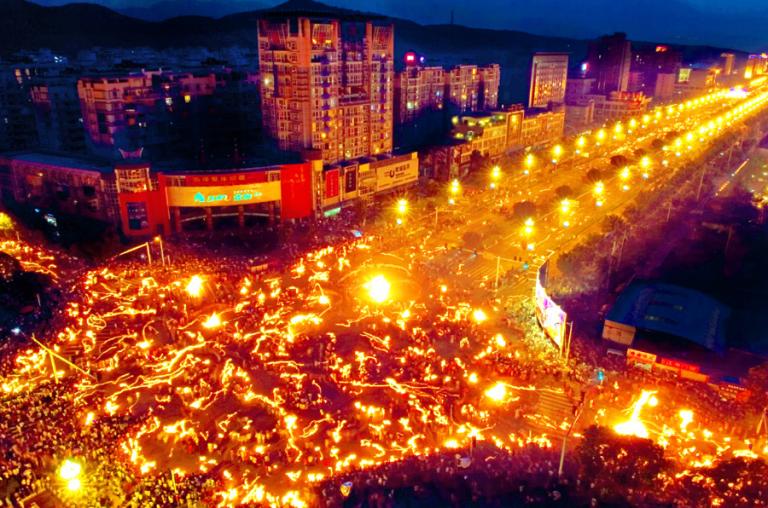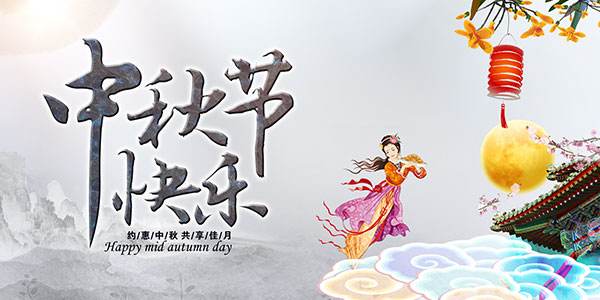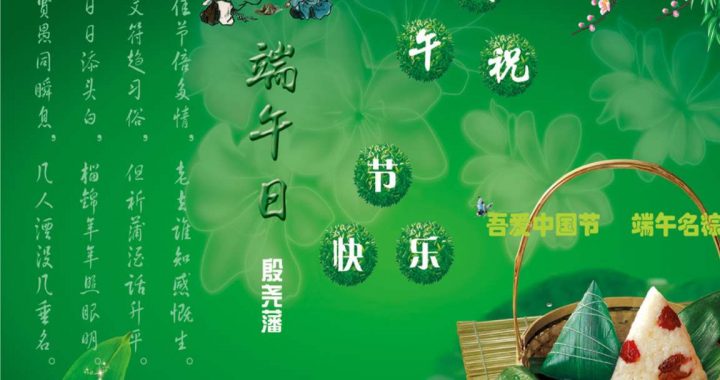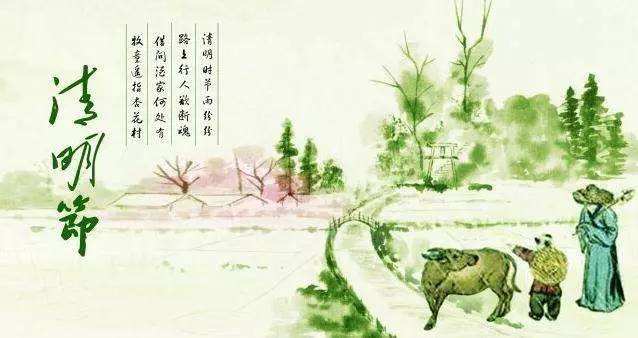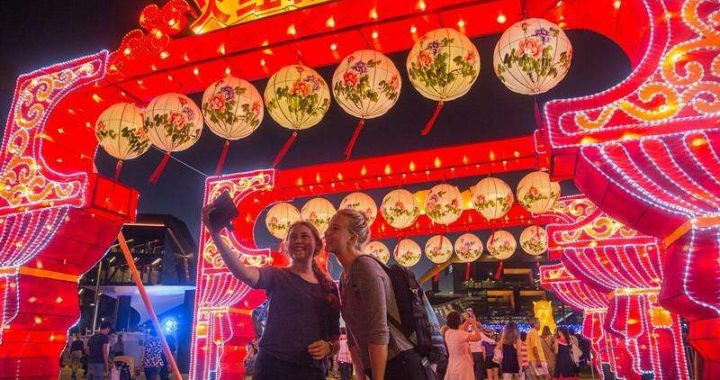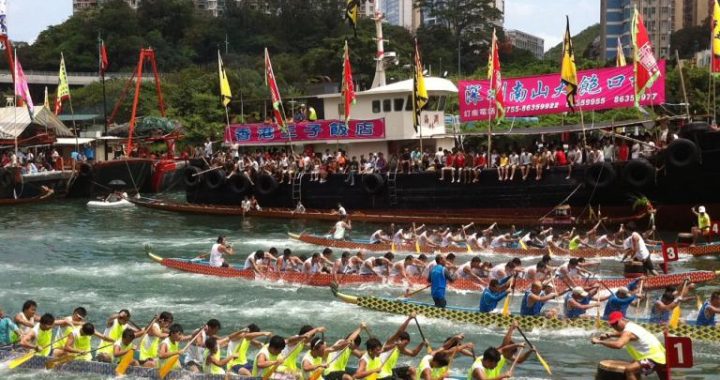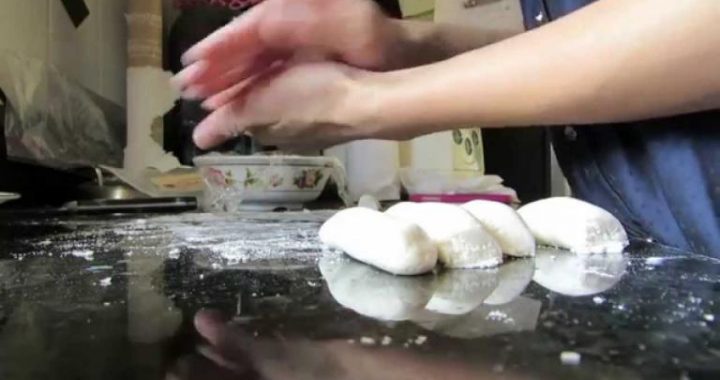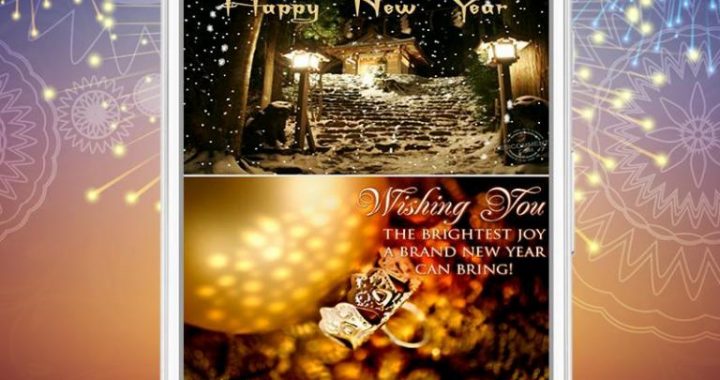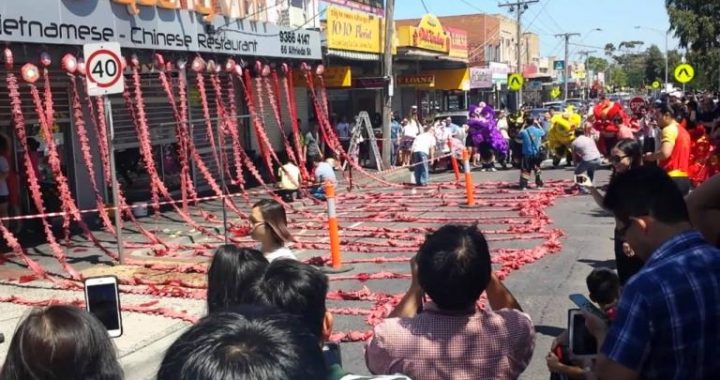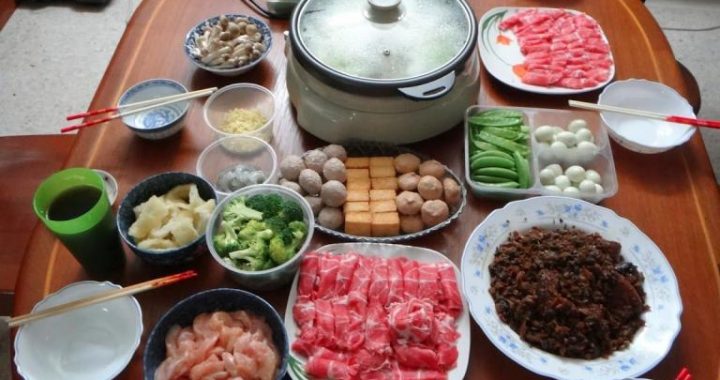Torch Festival
11 min readUnderstanding and use of fire contributed to man’s transition from barbarism to civilization. In various Chinese ethnic groups, there are many folk traditions about fire. Fire represents brightness, lighting up the dark night sky for man; fire represents warmth, driving away coldness from man; fire represents maturity, allowing man to eat cooked food; fire represents families, and the kitchen and fire room used to be the holiest spaces in the house. Meanwhile, fire also has the meanings of destruction and punishment in manycultures. Therefore, fire has been sanctified in many ethnic cultures and become a mediumfor communication between man and gods; even the Fire God in charge of man’s use of fire is created through personalization. The Torch Festival is related to people’s beliefs about fire.
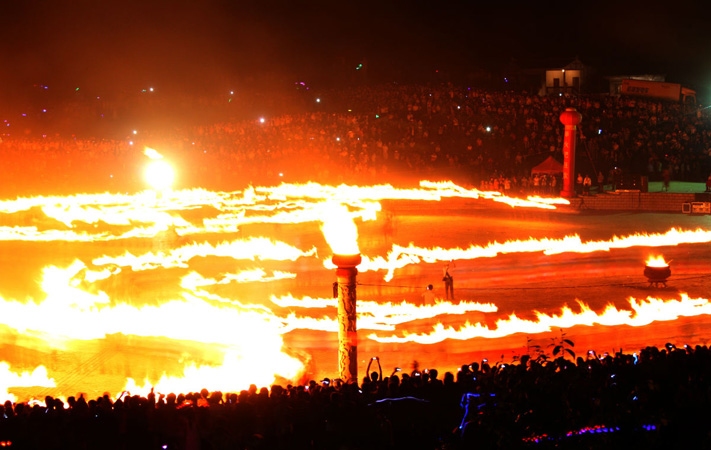
The Torch Festival is a common festival of ethnic groups speaking Yi language including the Yi,Bai,Naxi,Jino and Lahu ethnic groups.In these ethnic groups speaking Yilanguage,people have profound beliefs about fire and use fire to fumigate farmland,driveaway ghosts,eliminate plagues and disasters,kill insects to protect seedlings,accelerate the growth of ears,pray for bumper harvests,attract light and welcome good luck.In the numerous Yi legends about the origin of the Torch Festival,one important plot is constantly mentioned.It is said that in ancient times,gods released pests to land.To relieve the victims of the disaster,people decided to use fire to kill pests,so every family lighted up a torch and burned pests in crop fields day and night.After a hard struggle,man finally wiped out all pests and got a bumper harvest.To celebrate the victory,in the 6th lunar month every year,people light up fires and parade.Of course,the elements of carrying forward traditional moral views and praising goodhearted and brave women have been added to many anecdotes about the origin of the Torch Festival,but on the whole,its core is still related to fire worship.
Torch Festival periods are different in various ethnic groups.The Yi,Naxi and Jino ethnic groups celebrate the festival on the 24th day of the 6th lunar month,the Bai ethnic group celebrates the festival on the 25th day of the 6th lunar month,and the Lahu ethnic group celebrates the festival on the 201h day of the 61h lunar month.The Yi Torch Festival usually lasts three days.The first day’s activities are sacrifice offering and prayer.On this day,every Yi family should clean the house and,after cleaning the house,clean the chickens, sheep and pigs they have prepared as sacrifices to be offered during the Torch Festival. In Ninglang County, Yunnan Province, Yi hostesses should bring hens to buckwheat fields and offer them as sacrifices to the God of the Five Cereals. After completing these ceremonies, all families begin to slaughter cattle and sheep, prepare banquets and enjoy good wine and food. After nightfall, Yi clergymen and priests read scriptures and offer sacrifices to fire, and then adults and children take torches of wormwood bundles from priests’ hands, sing torch songs and wander near field boundaries.
On the second day of the Torch Festival, torches are relayed, and all families get together and hold traditional festival activities such as horse races, wrestling, singing, bullfights, goat fights and cockfights. On the third day of the Torch Festival, fire is sent back. This is also the climax of the Torch Festival. In Liangshan, Sichuan, after nightfall, all people run in stockade villages and streets holding torches in their hands. As fires glitter, shouting sounds resound through the skies. At last, people put the torches in their hands together to form many huge bonfires, and sing and dance around them. The scene is spectacular.
According to the Yi people’s thought,”stars are lights in the sky, and torches are lights in Yi families”and “winds blow white stones together, bows fluff cotton together and fires brings family members together.”In the revelry during the Torch Festival, people enhance mutual understanding, families become more cohesive, clans become more united, and the society becomes more harmonious.
Before the Bai Torch Festival, people in the whole village erect a big torch about 10 to 20 meters high made of pine trees felled on mountains, with the cost borne by the families that gave birth to children in the year. They also tie pine trees with wheat straws and hang grain-measuring containers made of paper strips on them. Small paper flags with auspicious words such as “making the state prosperous and people peaceful,””good weather for the crops”and “the land yield good harvests and the people en joy good health”around each grain-measuring container, and fireworks, firecrackers, lamps and lanterns are hung below. During the festival, all families go to their ancestors’ tombs with small torches, joss paper, joss sticks, candles and sacrifices to sweep them and offer sacrifices at noon.
After nightfall, men and women of all ages in the village gather around the big torch.0ld people in the village take the lead in offering sacrifices and kowtowing to the big torch.
Young men climb the towering big torch, use various families’ small torches to light up the big torch, and then set off firecrackers, beat drums and play music. When the bamboo poleson the torch under which grain-measuring containers hang are burned off, people vie with each other to get grain-measuring containers falling from above. Those who get them are deemed as blessed ones. The climax of the Bai Torch Festival is playing with torches.
Young men and women holding torches wander in fields. After an encounter, one quickly takes out a handful of resin powder out of the satchel and throws it at the other person’s torch. Whenever resin powder is thrown, dazzling firelight flashes and a sound of explosion is heard. The scene is joyous and festive.
The Torch Festival, as an important festival of ethnic groups speaking Yi language, especially the Yi ethnic group, has become these ethnic groups’ symbolic culture. Though these ethnic groups still partially follow the traditional mode of festival celebration in social life, under the influence of modernization, urbanization and globalization, the local and ethnic Torch Festival has been packaged and introduced into the context of tourist development, cultural heritage protection and modern media. Xichang, Sichuan began to hold the”International Torch Festival”in 1994, and held it every three years. This festival attracted numerous domestic and foreign tourists, made the Torch Festival well-known far and near, and was reputed as the “Chinese Carnival.”In 2006, upon the approval of the State Council, the Torch Festival was included into the list of the first batch of national intangible cultural heritage. The “Liangshan Yi Torch Festival”in Sichuan also received the title of one of the ten major Chinese folk festivals. In August 2008, the U.S. Overseas Chinese Ethnic Minority Federation also held the first “Torch Festival,”and introduced this traditional festival of the Yi people in China to Los Angeles. It lasted three days and three nights, and included the three stages of “offering sacrifices to fire,””passing fire”and “sending back fire.”
Through years of development, the government and the tourist industry have turned the Torch Festival into a festival tourism product. Though there are still burning torches and banquets, too much trade negotiation and sightseeing are mixed in it. The “Torch Festival” as a tourist product is already quite different from the Yi Torch Festival in the traditional sense.
Festivals are a culture of time, especially a culture of production time. If the time ofevery festival is arranged on one calendar, you can see that most festivals fall in the society’s leisure periods. Most religious festivals fall in such periods, to say nothing of productive festivals. At the starting points and breaks of spring sowing, summer farming.
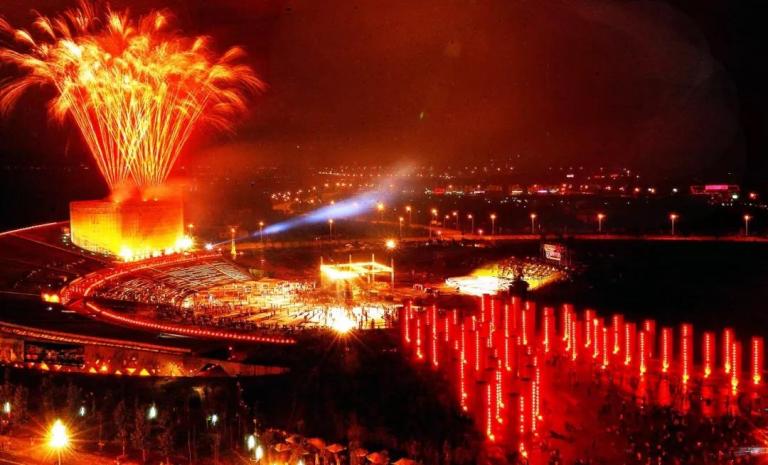
autumn harvesting and winter storage, there are colorful festival settings that inspire people to get ready for labor, allow people to pray for blessings with expectation or let people relax mentally and enjoy fruits. To sum up, people are always in this alternately tense and relaxed cultural network physically and mentally. The reason for this arrangement is very simple. Only in leisure periods can people have more energy to celebrate festivals. This ingenious arrangement of rhythms and rehabilitation is just the charm of festivals.
Double Second Festival: Spring Dragon Raises the Head In many Chinese areas, the 2d day of the 21d lunar month is deemed as the end of the Spring Festival. After the 21d day of the 21d lunar month, the whole Spring Festival is over. The extraordinary state of the Spring Festival changes into the normal state of production, and another year’s agricultural activities officially begin.
Gourds sold on the 2d day of the 21d lunar month in Huimin,Shandong(Taken by Wang Xuewen)
The origin of the Double Second Festival was related to observation of nature by people in farming life. In the Western Zhou Period (1046-771 BC) at the latest, people indicated the positions of the sun, the moon and stars in the sky with the 28 Lunar Mansions to determine seasons and remember farming seasons. Among the 28 Lunar Mansions, the seven lunar mansions of Jiao, Kang, Di, Fang Xin, Wei and Ji form a complete dragon
-shaped constellation, and the lunar mansion of Jiao is just like the dragon’s horns. In the night of the 21d day of the 21d lunar month, the “horns”of the “dragon”happen to rise slowly above the east horizon, hence the name “Dragon Head-raising.”The time is around the Waking of Insects, one of the 24 solar terms.”After the Waking of Insects, climates of different regions become similar.”With land thaws, dormant insects and animals become more and more active. Because the dragon is the head of all insects,”Dragon Head-raising”has become a symbol and the special position of the dragon in the Double Second Festival has been established.
The Double Second Festival is a composite festival. Since ancient times, it has consolidated the customs of the Waking of Insects, Vernal Equinox Day, Dragon Head Festival, Zhonghe Festival, Flower Festival and Land God Festival in the 21d lunar month of spring. Later these festivals gradually disappeared and were finally integrated into the customs of the Double Second Festival.
Flower fair during the Beijing Heilongguan temple fair on the 21d day of the 21d lunar month (Taken by Xu Tianji)
Various areas’ customs of the Double Second Festival are quite diversified and can be classified into activities and taboos by nature. Activities mainly include offering sacrifices to dragons, spraying ash, hitting girders, smoking worms, drawing water, cutting hair, putting small dragon tails on children’s heads, asking children to learn writing, welcoming married daughters’ return to their parents, eating pig heads, etc, and taboos mainly include stopping needlework, fetching no water early in the morning, etc. There used to be the custom of cutting hair on the 21d day of the 21d lunar month in most areas of North China, generally called “dragon haircut,”comparing people to dragons. Many customs and activities of the Double Second Festival do manifest people’s primitive thoughts related to dragons. In folk beliefs, dragons are not the same: some are benevolent and quite dedicative, some are naughty, some are lazy, and others are vicious. During the Double Second Festival, people either piously worship these gods in charge of rains with joss sticks, candles and sacrifices, or set various taboos in order not to offend them. Lazy dragons and vicious dragons are not treated politely. People stimulate them by hitting girders, eating fried beans(making dragons open their eyes), eating noodles(eating dragons’ beards), eating dumplings(eating dragons’ ears), eating flour pancakes(tearing off dragons’ scales), etc. The only purpose of doing these things is to let them bring clouds
and rains and ensure favorable weather and bumper grain harvests so as not to delay the farming season.
面面品
Traditional folk cultural activities such as welcoming dragon lanterns and rowing dragon boats held on the 21d day of the 21d lunar month in Yunxi Village,Liucheng She Town,Wuyi County,Zhejiang Most eating customs of the Double Second Festival are related to dragons.Beijing natives have the custom of”eating dragon scales”:they cook pancakes,add the”mixed dish”of fried shredded lean meat,spinach and blanched garlic leaves,apply sweet bean sauce with green union,roll them into the shape of a tube,and eat them with relish.In some northern areas,eating noodles on this day is called”eating dragons’beards”and”raisingdragons’heads,”eating pancakes is called”eating dragons’skins,”and eating dumplings is called”eating dragons’ears,””eating dragons’horns,””pressing dragons’eyes,””eating dragons’teeth,”etc.People in Jilin know how to economize well.They save the heads and trotters of the pigs eaten at the year-end for the Double Second Festival just to experience the wonderful feeling of”rain from the sky running on earth on the 2d day of the 21d lunar month when dragons raises their heads and every family eats dragon heads.”People in Shandong are famous for frugality.They like to say”after the Double Second Festival,there will be no bowl-shaped cake.””The bowl-shaped cake of the Double Second Festival”is a special phrase of rural people meaning a special opportunity.In the past,there was a sharpcontrast between farmers’life in ordinary day and in the Spring Festival,so on the 21d day of the 21d lunar month,the end of the Spring Festival,people were reluctant to let it go and looked for reasons to enjoy the last”luxury.”
Several Miao men playing reed pipes during the traditional activity held on the 2d day of the 21d lunar month in Dongtou Township, Rongshui Miao Autonomous County, Guangxi Huaer festival site in a mountain in Min County, Gansu Province (Taken by Qi Xiaoping)
In Shandong,”Datun”used to be the most popular folk activity of the Double Second Festival. Datun is also called “Dahuitun,””Weicang,””Huacang”and “Tiancang.”On the 21d day of the 21d lunar month, people get up early in the morning, put plant ash into dustpans,
use one wood stick to hit the dustpan edge while walking to let ash fall down slowly, shape the pattern of a granary consisting of ash lines, spray ash outside the ash granary to form a trapezoid, and then throw some cereals into the grain, hoping that granaries will be filled with grain after a bumper harvest. Watching old men and women say the proverb “on 21d day of the 21d lunar month, dragons raise their heads, and granaries of all sizes are full”
leisurely, we can know what a pleasure it is to run the ceremony personally. This embodies not only people’s strong hope for favorable weather and bumper grain harvests, but also an artistic and aesthetic sense of beauty in seizing happiness and relishing life.
The Double Second Festival is a fixed and mature festival in the agricultural society and can hardly be linked to the modern society. Like some traditional festivals, it is at an absolute disadvantage in the modern trend of emphasizing clearly distinction of time segments, convenient rhythms, provision of services and receipt of services, andis a festival increasingly distanced from the Chinese people.
